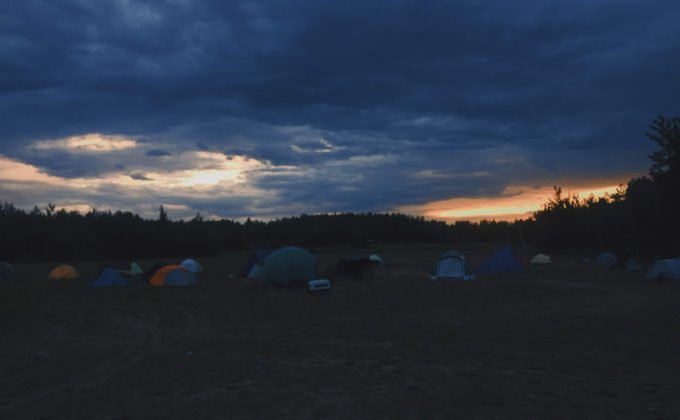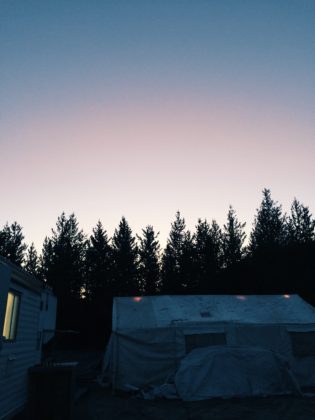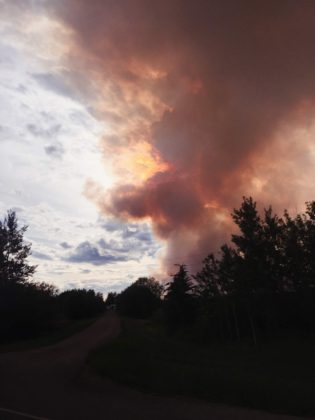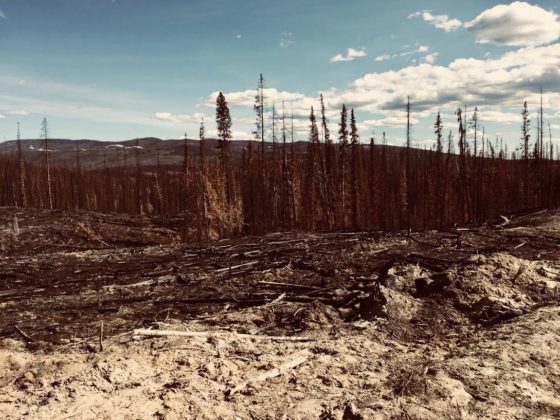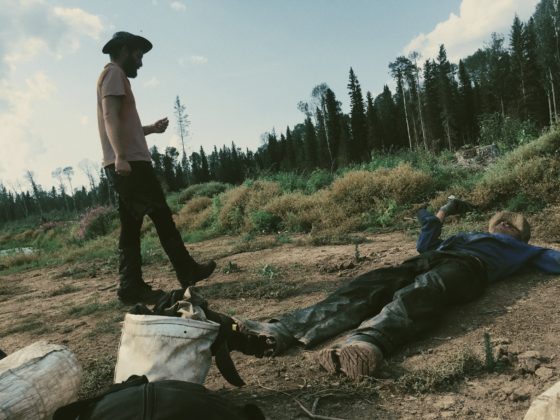Tree planting is a world of its own. It requires incredible physical and mental endurance and it gives planters the most challenging and rewarding experiences. Aside from the act of planting trees, the reason so many planters not only deal with the struggles of planting but come to love it is the people.
“I love the days where everything has gone wrong, and then it starts raining on top of that, and me and my planting partner just laugh and scream and make planting puns. Tree planters have an incredible ability to not just endure, but enjoy what’s thrown at them,” says three-year planting vet Micheal Prette.
Life in the bush moves from one Western Canadian town to another, across British Columbia and Alberta, with the season starting in May and ending in early August.
Living up a mountain an hour away from all service and civilization, tent city becomes a home in the forest. Spending a whole day surrounded by trees, open skies, and fresh air from dawn until bedtime is hard to find anywhere else.
“Being in a community of tree planters and being forced to endure the suffering that we do, pulls us out of our heads and into our bodies to a new place of feeling … that’s really the transformation of planting, it takes us into the deep places of our own feelings,” says Tim Tchida, owner of Summit Reforestation.
Édouard Gendron-de-Vette, a two-year vet, said a desire to feel connected to nature is why he came to tree planting.
“I feel like it’s an investment for the rest of the year, but also you never get in contact with that many people and with nature as much as you do here. Even if it’s pretty violent sometimes, especially with nature. Yeah, just like, back to the source, you know?”
After the Liberal Party’s announcement they would be planting two-billion trees as part of their climate change policy, the seeds have been planted for growth in the tree industry.
“This is a part of a bigger industry, a very incredible industry,” says Tchida. “We are doing something so amazingly honourable for putting back. We’re in a different time right now, we have an important responsibility to put back more than what we’ve taken.”
“It’s not just about planting trees, it’s not just a summer job and it definitely isn’t summer camp. It’s an opportunity to really open up to something new that you don’t even know is there yet,” Tchida says.
Bush Crazy
Bugs are the number one cause of bush crazy. Mosquitos hum around constantly, clouds of horseflies cover your arms and legs, leaving holes in your clothes and bites all over your skin, no-see-ums crawl into the corners of your eyes. There is no time to stop and itch. Plant faster, they say.
You think to yourself in nauseous anger and outrage if these creatures will ever leave.
Ah, glorious rain days where only a few of the detested creatures persist. Thunder roars above as you are soaked from head to toe, you can hear the water in your boots with every step you take. You are shivering. If you stop, you will freeze. Plant faster!
There are days when the weather is fine, miraculously there are hardly any bugs, and you still end up in tears in your foreman’s arms by noon.
The silence in the land gives you space to be with your thoughts for hours on end, another thing that leads to bush crazy.
“I love the days where everything has gone wrong, and then it starts raining on top of that, and me and my planting partner just laugh and scream and make planting puns. Tree planters have an incredible ability to not just endure, but enjoy what’s thrown at them,”
Micheal Prette, three-year planting vet
People are quitting. You wonder how on earth they could leave this place, and how you have not already.
Other days you spend crawling over and under logs, through the thickest of thorn bushes, hitting rocks every time you throw your shovel into the ground, sending jolts of pain all the way up your arm, with a ‘ting’ so loud your crew can hear it from miles away. You hear them holler that you hit “the only rock in ‘Berta!”
The weight of your trees in the bags on your hips is, for a moment, too much, and you fall backwards to the ground. For a sweet, sweet second, you lay in the dirt contemplating whether or not you should bother getting up at all. You stand up and keep planting.
Everything is on fire. Detours and police escorts on drives to a new camp because of fires, evacuated out of blocks because of fires. Fires jumping across a 700-metre wide river. No campfires anymore, because of the fires.
All of this makes planting what it is. You are pushed to the limits, and with all the very real blood, sweat and tears that go into it, you see another side of yourself that you are insanely proud of.
“All tree planters that have endured are now the high ballers of society,” says Tchida.
He calls planting, “forced western meditation.”
The Language of Planting
Made withVisme Infographic Maker
Along with everything else planting throws at you is a whole new language. Shnarb: for land that is full of fallen logs, slash, thorns. Cream (alternatively, cream show) is the soft ground planters dream of. Creaming out or stealing someone else’s cream is frowned upon.
Cameron Fox, a third-year planter, is passionate about his preferred planting slang, “Oh shnarb, absolutely shnarb, hands-down favourite word, shnarb.”
For rookies, tree planting is daunting within the first few weeks of adjusting to the lifestyle. Many have not a clue of how to put a tree in the ground, how fast it has to be done, and the quality specifications that come with it. Staring out into a cut block filled with fallen logs, mud, green growth, it is hard to even know where to start.
The rookie stare. Blank and confused. Hilarious in hindsight and incredibly frustrating in the moment. That is the beauty of it. Eventually, you just put a tree in the ground. Planting forces you to take a step even if you do not know where you will end up.
Each day a planter is given a map of their piece and a certain amount of trees to plant for the day.
One hand on the shovel, the other grabs a tree, plant it straight, tight, and deep. The mills which provide the trees have varying specifications for quality such as density. This tells the planter how far apart to plant the trees.
Checkers then come around to check the quality and density of your trees and if it is not up to par, you have to repo–meaning you have to replant any trees that do not meet the standard of straight, tight and deep, as well as other requirements specific to the contract. This can take anywhere from 20 minutes to a whole day going back through planted ground and fixing leaners, open holes or shallow trees.
Planters do not get paid to repo. They are paid for each tree planted, not for the time spent fixing bad trees. Repo one too many times, and you could be fired. Not hitting good enough numbers in time, you could be fired.
Planting forces you to take a step even if you do not know where you will end up.
Planters are paid by the tree. The base price is around 13 cents on fast ground, meaning soft-land and little green growth. Getting the base price means expectation to hit high numbers upwards of 2,000 trees a day at least for rookies, with most vets hitting around 3,000 to 4,000, and high ballers hitting around 4,000 to 5,000. However, those numbers fluctuate with the conditions and increase over time in the season.
Prices can be increased for various reasons, but it comes down to anything that considerably lessens your productivity and is out of your control such as a long drive to the block or tall thorn bushes. Price bumps usually increase to about 14 to 15 cents, with really terrible land sometimes priced at 16 to 17 cents.
For the company Summit, the average season earnings in 2019 for all planters was $14,832 and the average for all vets was $18,668. The top planter in the company made $28,563.
The need to hit better numbers creates immense pressure for planters, especially rookies, but at the same time pushes them to do more than they believe they are capable of.
“Having people leave is tragic, I hate when people quit. Because it’s not about the planting trees, I know we’re always going to get them done. But because that quitting is a loss of chance for something new,” said Tchida.
Life outside the forest
Planting usually goes in shifts of three days on, one day off. The energy on ‘planting Friday,’ each third day of the shift, is always racing to finish the day and get on with partying.
After spending around seven to 10 hours in the land for days on end, the celebrations are a must.
Nights after planting are spent picking out thorns by the fire and talking about everything that happened that day. Nights off are for music by the fire, themed nights like bushmas and bush prom, or motel shows and Northern Albertan clubs like the famed Stardust.
Days off are spent at the laundromat, loading up on bug spray and duct tape, and calls to family and friends.
The only time I hate planting is when I’m planting. It is long, exhausting, boring, painful, tiring, amazing, incredible, fulfilling, fun, terrible work and I can’t get enough.”
-Micheal Prette
“Living in the moment…comes so naturally [to] tree planting because there’s nothing I’d rather be doing than nothing on a day off, it’s nice to just sit in a chair and stare at a wall,” says Fox with a laugh.
After the whirlwind of a season comes to an end, nostalgia sets in.
Fox comments on what it is like to miss life in the bush. “After my first season, I was like I gotta go back immediately, like all I thought about all year round and then second season, a little less…but it also ties back into, I have to live in the moment while I’m here too, I can’t be living for that next season, I have to live for this part too, even though I can’t wait to graduate and plant year round…Me and my original friends who went together, we’re gonna go to Australia after the season.”
Tchida explains, “It’s ultimately an initiation into a new place in our lives, an initiation that we’ve lost in our culture. It’s the greatest opportunity for all of us to be opened up to a new place in ourselves and that’s just through learning how to endure suffering and embrace gratitude.”
For helicopter work, a planter is flown into a block and given a certain amount of trees for the day which are to be planted before they are picked up. The rush to plant as fast as humanly possible to get all those trees in the ground at the end of the day is called the heli hustle.
There is a huge support system to comfort and encourage one another when things are not working out. Planters only make what they each work hard enough to earn, so everyone wants to see each other succeed.
“We learn how to become our best selves through tree planting. If that foundation in a company of care and safety and reward is there, the suffering in planting is still there, we just have a solid foundation to be able to work through it with ourselves,” says Tchida.
In the land, aside from solo missions, you have a planting partner. Whoever you end up with will be there for your highest highs and lowest lows.
“The effort is the reward rather than the money and trees because the money and the trees are so fickle”
Cameron Fox, three year planting Vet
Fox explains the joys of having a planting partner.
“It was the first really cold rain day that we had and half the crew was quitting, but me and my friend were laughing so hard because we were delirious about how (messed) up everything was…I was in tears, crying, on my knees laughing just making stupid jokes,” he said.
“It was a terrible day, so many people quit, and it got so cold, and we just had a blast, you know?”
Safety
Samantha Rush, a planter for three years and foreman for two, shares two incidents which show major room for improvement in the safety of tree planting companies. During her years in the planting industry, she has witnessed two deaths.
“[The first] was an older guy, he’d been planting for probably 20 years…He had a heart attack and face-planted into a puddle and we didn’t end up finding him until maybe like three or four hours after it happened. [Foremen] don’t always get to see everyone as much as [they] want to. That’s what leads to things like this,” she said.
“The second one…they were drinking. They were joy-riding on the logging roads, taking turns riding on the top of the vehicle…Another vehicle was coming up the logging road and they had to swerve out of the way so that they wouldn’t crash, and the driver lost control of the vehicle and skidded down a bank, and the guy who was riding on top of the truck went flying off and hit a tree.”
Most reputable planting companies have strict rules against drinking anywhere near company vehicles and make sure keys are taken before nights off, along with other preventative and informative measures. In the land, radios are given to planters so they can communicate with foremen and helicopter pilots throughout the day.
“I’ve seen things change as I’ve been in the industry,” Rush says, though changes still need to be made to ensure better safety for planters.
Michael Prette explains his love-hate relationship with planting.
“In the off-season, I watch videos, look at pictures, listen to songs and reminisce about my summers in the bush. Two minutes into the job I remember every awful thing. The only time I hate planting is when I’m planting. It is long, exhausting, boring, painful, tiring, amazing, incredible, fulfilling, fun, terrible work and I can’t get enough.”
Fox says his mentality shifted in the past season.
“The effort is the reward rather than the money and trees because the money and the trees are so fickle. Some days you won’t plant anything and it’s not your fault…you’ll be driving for two hours or it’ll be a far block or a walk-in…If that happens you’re just going to be so disappointed in yourself but if you just focus on your effort you’ll always be satisfied.”
Feature Image by Preslea Normand. Infographic by Marieta-rita Osezua.



